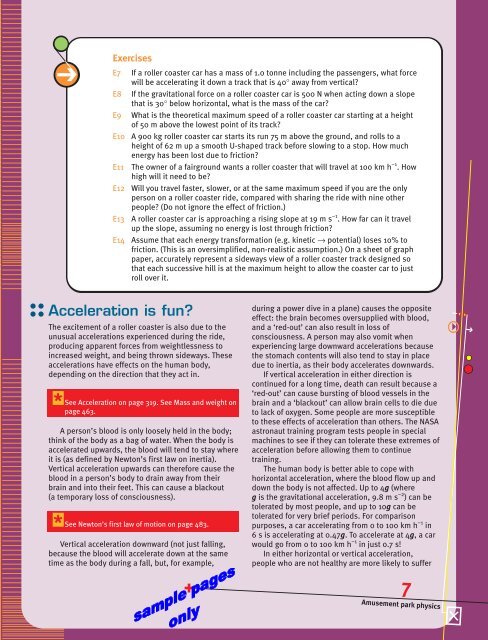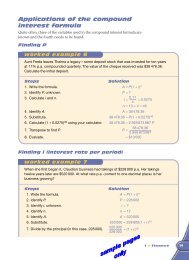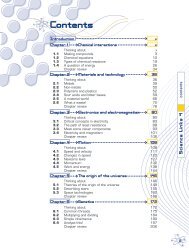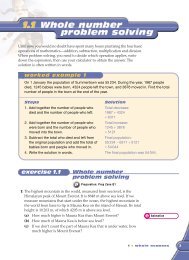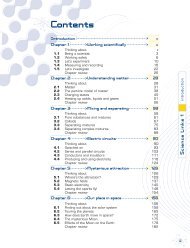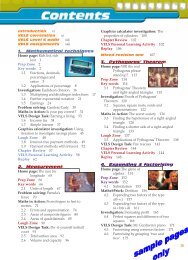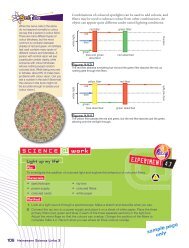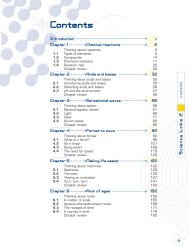Context 1: Amusement Park Physics - hi.com.au
Context 1: Amusement Park Physics - hi.com.au
Context 1: Amusement Park Physics - hi.com.au
You also want an ePaper? Increase the reach of your titles
YUMPU automatically turns print PDFs into web optimized ePapers that Google loves.
➔<br />
Exercises<br />
E7 If a roller coaster car has a mass of 1.0 tonne including the passengers, what force<br />
will be accelerating it down a track that is 40° away from vertical?<br />
E8 If the gravitational force on a roller coaster car is 500 N when acting down a slope<br />
that is 30° below horizontal, what is the mass of the car?<br />
E9 What is the theoretical maximum speed of a roller coaster car starting at a height<br />
of 50 m above the lowest point of its track?<br />
E10 A 900 kg roller coaster car starts its run 75 m above the ground, and rolls to a<br />
height of 62 m up a smooth U-shaped track before slowing to a stop. How much<br />
energy has been lost due to friction?<br />
E11 The owner of a fairground wants a roller coaster that will travel at 100 km h –1 . How<br />
<strong>hi</strong>gh will it need to be?<br />
E12 Will you travel faster, slower, or at the same maximum speed if you are the only<br />
person on a roller coaster ride, <strong>com</strong>pared with sharing the ride with nine other<br />
people? (Do not ignore the effect of friction.)<br />
E13 A roller coaster car is approac<strong>hi</strong>ng a rising slope at 19 m s –1 . How far can it travel<br />
up the slope, assuming no energy is lost through friction?<br />
E14 Assume that each energy transformation (e.g. kinetic → potential) loses 10% to<br />
friction. (T<strong>hi</strong>s is an oversimplified, non-realistic assumption.) On a sheet of graph<br />
paper, accurately represent a sideways view of a roller coaster track designed so<br />
that each successive <strong>hi</strong>ll is at the maximum height to allow the coaster car to just<br />
roll over it.<br />
Acceleration is fun?<br />
The excitement of a roller coaster is also due to the<br />
unusual accelerations experienced during the ride,<br />
producing apparent forces from weightlessness to<br />
increased weight, and being thrown sideways. These<br />
accelerations have effects on the human body,<br />
depending on the direction that they act in.<br />
* See Acceleration on page 319. See Mass and weight on<br />
page 463.<br />
A person’s blood is only loosely held in the body;<br />
t<strong>hi</strong>nk of the body as a bag of water. When the body is<br />
accelerated upwards, the blood will tend to stay where<br />
it is (as defined by Newton’s first law on inertia).<br />
Vertical acceleration upwards can therefore c<strong>au</strong>se the<br />
blood in a person’s body to drain away from their<br />
brain and into their feet. T<strong>hi</strong>s can c<strong>au</strong>se a blackout<br />
(a temporary loss of consciousness).<br />
* See Newton’s first law of motion on page 483.<br />
Vertical acceleration downward (not just falling,<br />
bec<strong>au</strong>se the blood will accelerate down at the same<br />
time as the body during a fall, but, for example,<br />
✚<br />
during a power dive in a plane) c<strong>au</strong>ses the opposite<br />
effect: the brain be<strong>com</strong>es oversupplied with blood,<br />
and a ‘red-out’ can also result in loss of<br />
consciousness. A person may also vomit when<br />
experiencing large downward accelerations bec<strong>au</strong>se<br />
the stomach contents will also tend to stay in place<br />
due to inertia, as their body accelerates downwards.<br />
If vertical acceleration in either direction is<br />
continued for a long time, death can result bec<strong>au</strong>se a<br />
‘red-out’ can c<strong>au</strong>se bursting of blood vessels in the<br />
brain and a ‘blackout’ can allow brain cells to die due<br />
to lack of oxygen. Some people are more susceptible<br />
to these effects of acceleration than others. The NASA<br />
astron<strong>au</strong>t training program tests people in special<br />
mac<strong>hi</strong>nes to see if they can tolerate these extremes of<br />
acceleration before allowing them to continue<br />
training.<br />
The human body is better able to cope with<br />
horizontal acceleration, where the blood flow up and<br />
down the body is not affected. Up to 4g (where<br />
g is the gravitational acceleration, 9.8 m s –2 ) can be<br />
tolerated by most people, and up to 10g can be<br />
tolerated for very brief periods. For <strong>com</strong>parison<br />
purposes, a car accelerating from 0 to 100 km h –1 in<br />
6sis accelerating at 0.47g. To accelerate at 4g, a car<br />
would go from 0 to 100 km h –1 in just 0.7 s!<br />
In either horizontal or vertical acceleration,<br />
people who are not healthy are more likely to suffer<br />
7<br />
<strong>Amusement</strong> park physics<br />
<br />
<br />
⌧<br />
➔


